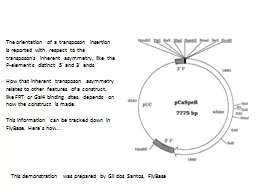/


insertion is reported with respect to the transposons inherent asymmetry like the Pelements distinct 5 and 3 ends How that inherent transposon asymmetry relates to other features of a construct like FRT or Gal4 binding sites depends on how the construct is made ID: 780192
Download The PPT/PDF document "The orientation of a transposon" is the property of its rightful owner. Permission is granted to download and print the materials on this web site for personal, non-commercial use only, and to display it on your personal computer provided you do not modify the materials and that you retain all copyright notices contained in the materials. By downloading content from our website, you accept the terms of this agreement.
Slide1
The
orientation of a transposon insertion is reported with respect to the transposon's inherent asymmetry, like the P-element's distinct 5' and 3' ends.How that inherent transposon asymmetry relates to other features of a construct, like FRT or Gal4 binding sites, depends on how the construct is made.This information can be tracked down in FlyBase. Here’s how...
This demonstration was
prepared by Gil
dos Santos, FlyBase
Slide2HP21640
5’
3
’
There are 2 EP/EP-like insertions in the region. If the triangle points up, it means that the P5’-to-P3’ direction is oriented on the “minus” strand, relative to the genomic scaffold.
We’ll need to track down info about each kind of construct, {
EPg
}
vs
{EP} in
FlyBase
.
Click on the blue triangle for the insertion of interest...
I want to drive ectopic “
cbs
” expression:
Slide3Clicking on the triangle for HP21640
takes you to the transposon insertion report.From there, look for the “Inserted element” link. Follow that to get info about the construct itself.
The “Segments & Size” section of the construct
report describes what’s in the EP element,
relative to the P5’ and P3’ ends. Click on each
segment to get more info:
e.g., “CaSpeR_P5” has the mini-white cassette.
e.g., The GAGA and UAS sites are nested just
inside of the P3’.
I would infer that EP-driven transcription
proceeds through P3’. See references for more info
. You may find the GDP’s
maps of commonly used constructs helpful.
Slide4EP-driven
HP21640
5’
3
’
{
EPg
}-driven
transcription
From the info about the “
EPg
” construct, I would infer that transcription of this HP21640
insertion proceeds through the P3’ ends, away from the “
cbs
” gene.
Figuring out P{EPg}HP21640
Slide5EP-driven
G2391
3
’
5’
{EP}-driven
transcription
There’s another EP-type element in the region: G2391. Following the same procedure, I
figured out that the GAGA and UAS sites are nested just within P3’ end.
The blue triangle points down, meaning the 5’-to-3’ orientation of the P-element is along the
plus strand (relative to the genome). This is the one I want.
Figuring out P{EP}G2391